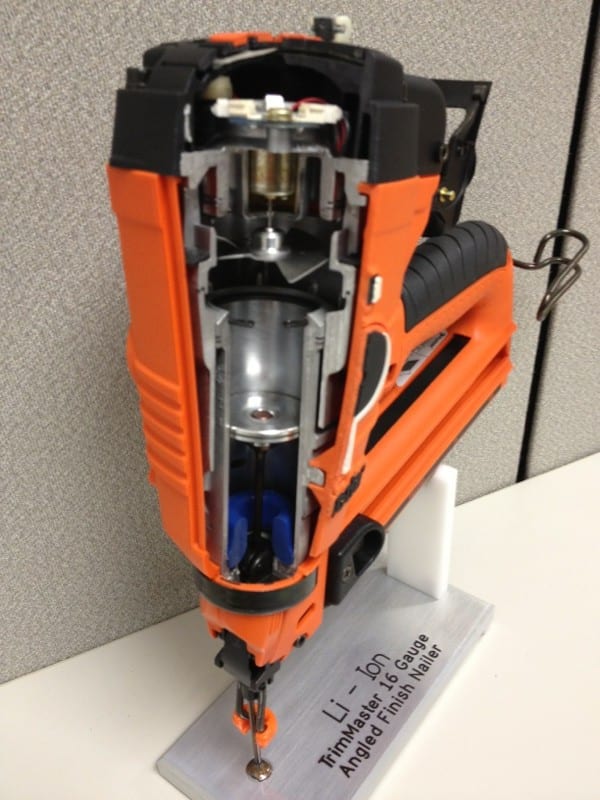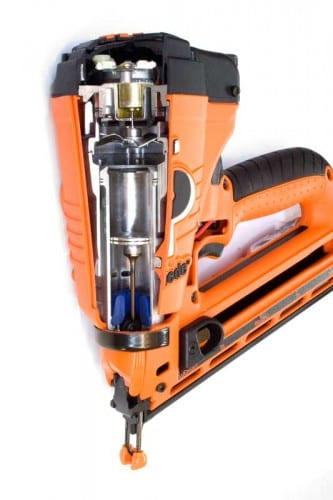We like to break down the technology that we all pretty much take for granted. We consistently find ourselves using cordless fuel nailers or gas nailers. It suddenly occurred to us that this “simple” cordless tool actually uses incredibly complex components. Not content to simply take anyone’s word for it, we opened up a Paslode CF325Li cordless nailer and took a look at the internals to see how gas nailers work.
We quickly realized we needed to go straight to the source for more information. We called Warren Corrado, product manager for Paslode, the company that invented the cordless fuel-powered nailer. He gave us tons of information regarding how gas nailers work.
How Gas Nailers Work, An Overview
The history of the pneumatic nailer actually starts with pallets and furniture. If this doesn’t interest you, feel free to skip to the next paragraph where we talk more about technology. In understanding how gas nailers work, however, it helps to start at the beginning.
Paslode introduced the very first pneumatic tool back in 1959 in the form of an upholstery tacker. Other similar products handled tasks like pallet crating. During the mid-80s, however, Paslode started to observe that hoses and such were cumbersome. This presented particular problems with stud wall and larger projects. That birthed the cordless Impulse nailer. Fuel-powered nailers were another breed.
When replacing the air supply of pneumatic framing nailers or finish nailers with a fuel cartridge, getting the piston to return back to the firing position presented one of the biggest hurdles. Prototypes revealed that the rapid heat changes created a vacuum effect. This essentially solved this problem—call it a happy accident. Both the problem and solution resemble a one-cylinder combustion engine.
The 9-Step Firing Process
The main function of how gas nailers work comes down to firing off nails. You can break down the firing process into 9 steps:
- Press the tip against the work surface
- Fuel gets dosed into the system’s firing chamber
- The upper cylinder closes (like closing intake valves on a gas engine) and the trigger mechanism is released
- The fan starts up and mixes the air and fuel
- Pull the trigger
- The battery generates spark at the combustion chamber head which ignites the fuel/air mixture
- This rapid expansion of gasses drives the blade down, which shears one nail off the strip and drives it in
- The thermodynamic gas effect sucks the driver blade and piston back into its ready position
- When the tool comes off the workpiece, the exhaust gets vented and the fan continues to spin. This preps the chamber to take its next shot.
In looking at how gas nailers work, the effectiveness of the system really impresses us to no end. The same basic technology works to drive nails as small as brads all the way up to 3-1/2″ framing nails.
The electronics also play a huge role in how gas nailers work and use fuel so effectively. They make the difference between reliability and a tool that doesn’t keep up. A microprocessor, which also runs off the battery, ensures everything operates properly. It monitors the number of shots, the speed, and any faults.
Maintenance and Wear on Gas Nailers
On previous models, and up until 4-5 years ago, a large O-ring would seal the combustion chamber. This served as the Achilles heel of the system and a major point of potential tool failure. Paslode replaced this in newer models. New fuel nailer systems use a steel ring that increases durability. It also keeps the engine cleaner while it removes a major fault point. Modern fuel nailers can drive around 50,000 nails on average between cleanings.
Keeping the engine clean is important (much like a vehicle) and pneumatic tools require oil on a regular basis. The fuel used in this type of nailer already includes oil, however. It lets users of fuel or gas nailers removed that step from the regular use of the tool. Only when you clean it do you need to add oil. This type of preventative maintenance maintains the tool over the long haul. It works out to around 10-15 minutes of downtime once per month for a heavy user.
The Future of Gas Nailers and Cordless Fuel Nailers
Gas-powered cordless nailers aren’t the only game in town. Battery-powered options also exist. In fact, more and more battery-only nailers come to market every year. In 2020, we even saw the introduction of the DeWalt 20V cordless roofing nailer. Keep in mind, however, that 18V and larger batteries add pounds to the weight of the tool. That matters.
Fuel + battery solutions give users greater energy density (the amount of power delivered per mass). Overall, the fuel-powered nailer is an efficient and lightweight tool, given what it can do. So what’s in store for the future? Well, we already have fuel-powered framing, roofing, finish and brad nailers in addition to staplers. Perhaps more powerful and lighter tools (greater power-to-weight) and even further improvements in reliability and durability for the professional user are around the corner.
Where battery-only cordless framing nailers used to stall out in cold temperatures, advancements in lithium-ion battery technology have rejuvenated the market. On the fuel nailer side, Paslode created framing fuel with an All-Season formula. That Paslode fuel cell drives as many as 1,200 nails—even in the cold.




